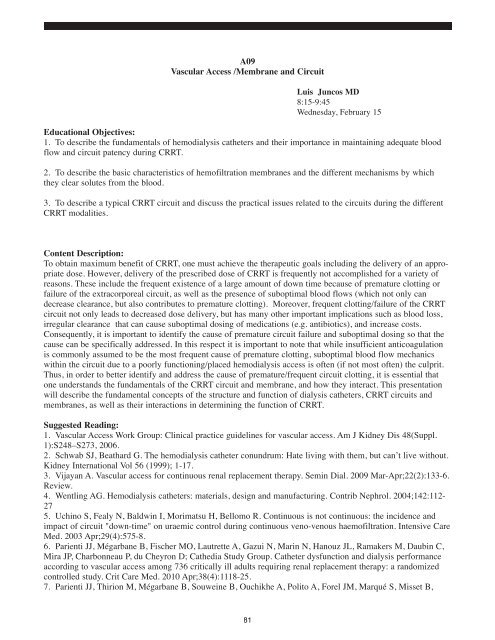ABSTRACTS from 16th International COnference on ... - CRRT Online
ABSTRACTS from 16th International COnference on ... - CRRT Online
ABSTRACTS from 16th International COnference on ... - CRRT Online
You also want an ePaper? Increase the reach of your titles
YUMPU automatically turns print PDFs into web optimized ePapers that Google loves.
A09<br />
Vascular Access /Membrane and Circuit<br />
Luis Juncos MD<br />
8:15-9:45<br />
Wednesday, February 15<br />
Educati<strong>on</strong>al Objectives:<br />
1. To describe the fundamentals of hemodialysis catheters and their importance in maintaining adequate blood<br />
flow and circuit patency during <strong>CRRT</strong>.<br />
2. To describe the basic characteristics of hemofiltrati<strong>on</strong> membranes and the different mechanisms by which<br />
they clear solutes <str<strong>on</strong>g>from</str<strong>on</strong>g> the blood.<br />
3. To describe a typical <strong>CRRT</strong> circuit and discuss the practical issues related to the circuits during the different<br />
<strong>CRRT</strong> modalities.<br />
C<strong>on</strong>tent Descripti<strong>on</strong>:<br />
To obtain maximum benefit of <strong>CRRT</strong>, <strong>on</strong>e must achieve the therapeutic goals including the delivery of an appropriate<br />
dose. However, delivery of the prescribed dose of <strong>CRRT</strong> is frequently not accomplished for a variety of<br />
reas<strong>on</strong>s. These include the frequent existence of a large amount of down time because of premature clotting or<br />
failure of the extracorporeal circuit, as well as the presence of suboptimal blood flows (which not <strong>on</strong>ly can<br />
decrease clearance, but also c<strong>on</strong>tributes to premature clotting). Moreover, frequent clotting/failure of the <strong>CRRT</strong><br />
circuit not <strong>on</strong>ly leads to decreased dose delivery, but has many other important implicati<strong>on</strong>s such as blood loss,<br />
irregular clearance that can cause suboptimal dosing of medicati<strong>on</strong>s (e.g. antibiotics), and increase costs.<br />
C<strong>on</strong>sequently, it is important to identify the cause of premature circuit failure and suboptimal dosing so that the<br />
cause can be specifically addressed. In this respect it is important to note that while insufficient anticoagulati<strong>on</strong><br />
is comm<strong>on</strong>ly assumed to be the most frequent cause of premature clotting, suboptimal blood flow mechanics<br />
within the circuit due to a poorly functi<strong>on</strong>ing/placed hemodialysis access is often (if not most often) the culprit.<br />
Thus, in order to better identify and address the cause of premature/frequent circuit clotting, it is essential that<br />
<strong>on</strong>e understands the fundamentals of the <strong>CRRT</strong> circuit and membrane, and how they interact. This presentati<strong>on</strong><br />
will describe the fundamental c<strong>on</strong>cepts of the structure and functi<strong>on</strong> of dialysis catheters, <strong>CRRT</strong> circuits and<br />
membranes, as well as their interacti<strong>on</strong>s in determining the functi<strong>on</strong> of <strong>CRRT</strong>.<br />
Suggested Reading:<br />
1. Vascular Access Work Group: Clinical practice guidelines for vascular access. Am J Kidney Dis 48(Suppl.<br />
1):S248–S273, 2006.<br />
2. Schwab SJ, Beathard G. The hemodialysis catheter c<strong>on</strong>undrum: Hate living with them, but can’t live without.<br />
Kidney <str<strong>on</strong>g>Internati<strong>on</strong>al</str<strong>on</strong>g> Vol 56 (1999); 1-17.<br />
3. Vijayan A. Vascular access for c<strong>on</strong>tinuous renal replacement therapy. Semin Dial. 2009 Mar-Apr;22(2):133-6.<br />
Review.<br />
4. Wentling AG. Hemodialysis catheters: materials, design and manufacturing. C<strong>on</strong>trib Nephrol. 2004;142:112-<br />
27<br />
5. Uchino S, Fealy N, Baldwin I, Morimatsu H, Bellomo R. C<strong>on</strong>tinuous is not c<strong>on</strong>tinuous: the incidence and<br />
impact of circuit "down-time" <strong>on</strong> uraemic c<strong>on</strong>trol during c<strong>on</strong>tinuous veno-venous haemofiltrati<strong>on</strong>. Intensive Care<br />
Med. 2003 Apr;29(4):575-8.<br />
6. Parienti JJ, Mégarbane B, Fischer MO, Lautrette A, Gazui N, Marin N, Hanouz JL, Ramakers M, Daubin C,<br />
Mira JP, Charb<strong>on</strong>neau P, du Cheyr<strong>on</strong> D; Cathedia Study Group. Catheter dysfuncti<strong>on</strong> and dialysis performance<br />
according to vascular access am<strong>on</strong>g 736 critically ill adults requiring renal replacement therapy: a randomized<br />
c<strong>on</strong>trolled study. Crit Care Med. 2010 Apr;38(4):1118-25.<br />
7. Parienti JJ, Thiri<strong>on</strong> M, Mégarbane B, Souweine B, Ouchikhe A, Polito A, Forel JM, Marqué S, Misset B,<br />
81
















